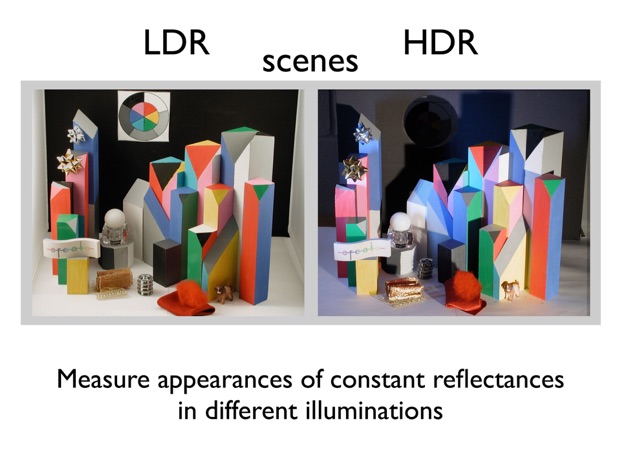Do humans discount the illumination?
J. J. McCann, “Do humans discount the illuminant?”, In Proc. SPIE Vol. 5666,
Human Vision and Electronic Imaging X; B. E. Rogowitz, T. N. Pappas, S. J. Daly; Eds., San Jose, p. 9-16, 2005.
05a EI5666 3.pdf
Abstract
In constancy experiments, humans report very small changes in appearance with substantial illumination changes. Hermann von Helmholtz introduced the term “discounting the illuminant” to describe 19th century thinking about underlying mechanisms of constancy. It uses an indirect approach. Since observers see objects as constant, observers “must” be able to detect the spatial and spectral changes in illumination and automatically compensate by altering the signals from the quanta catches of retinal receptors. Instead of solving the problem directly by calculating an object’s reflectance from the array of scene radiances,
Helmholtz chose to solve the problem of identifying the illumination. Twentieth century experiments by Hubel and Wiesel, Campbell, Land, and Gibson demonstrate the power of mechanisms using spatial comparisons. This paper analyses a series of different experiments looking for unequivocal evidence that either supports “discounting the illuminant” or supports spatial comparisons as the underlying mechanism of constancy.
_____________
Mechanism of Color Constancy
-
J.J. McCann, Mechanism of Color Constancy, Proc. IS&T/SID Color Imaging Conference, IS&T/SID, Scottsdale, Arizona, 12, 29-36, 2004.
04c CIC12.pdf
Abstract
There are two widely held theories of color constancy based on very different mechanisms: Chromatic Adaptation and Spatial Comparisons. Chromatic Adaptation is based on the change of retinal sensitivity in response to changes in incident light. The Spatial Comparisons mechanism is insensitive to illumination changes because it uses ratios of radiance from different pixels in the image. A spatially uniform increase in long-wave light increases both the numerator and the denominator by the same factor, so that the ratio remains constant. Spatial Comparisons of all pixels in the image synthesize a constant image, when the long-, middle-, and short-wave images are processed independently.
Measurements of color appearance in constancy experiments have shown that there are small consistent departures from perfect constancy. This paper measures the color and magnitude of these departures from perfect color constancy. It tests the hypothesis that these departures provide a signature of the underlying constancy mechanism. Since Chromatic Adaptation mechanism is specific for illumination, then these departures are predicted to be the same, regardless of the color of the paper. Since the Spatial Comparisons mechanism is based on the Integrated Reflectance of the paper, gray papers should show greater constancy than colored papers. In other words, the signature of Chromatic Adaptation is constant departures for each illumination, while the signature of Spatial Comparisons is variable departures for each reflectance. This paper measures the color matches for a yellow, a purple and a gray paper in 27 different illuminants.
________________
Do we discount or ignore illumination?
McCann J J, 2006, "Do we discount or ignore illumination?"
Perception 35 ECVP Abstract Supplement
http://www.perceptionweb.com/abstract.cgi?id=v060370
Changes in the spectral composition of illuminants produce small, but consistent, departures from perfect colour constancy. These departures from perfect constancy provide a signature of the mechanism. We used a constant set of coloured papers in 27 different spectral illuminants. [All possible combinations of 3 intensities (1, 2, and 4 LEDs) for wavelengths 455, 530, and 625 nm]. Observers matched a gray, a purple, and an orange paper in each illuminant to chips in a Munsell book in constant spectral illumination. If we discount illumination, we need first to identify it. Departures from perfect constancy are held to be incomplete adaptations to each illuminant. The pattern in colour space of these departures should follow the pattern of illuminants. If, instead, we ignore the illumination and build the colour appearance from spatial comparisons (ratios), then changes of illumination affect equally both the numerator and the denominator of these spatial ratios. The overlap of cone spectral sensitivities creates chromatic crosstalk, which, in turn, affects spatial ratios for colourful papers, but not for grays. If we ignore illumination, then the signature of departures from constancy should vary with the reflectances of the papers, not the illuminants. Observer matches confirm the second, spatial-reflectance, hypothesis.






